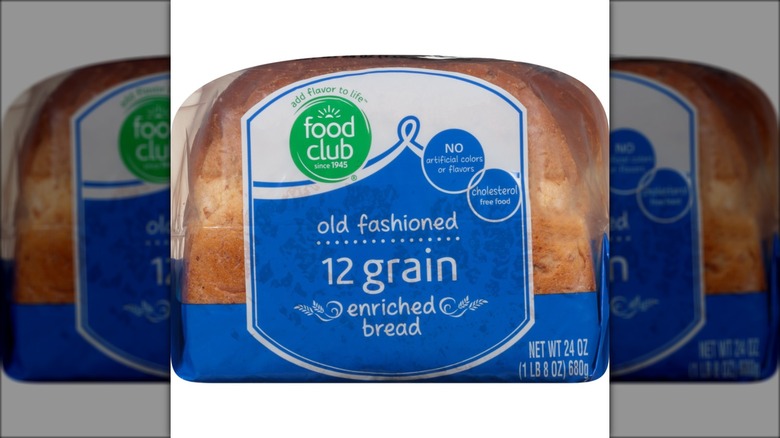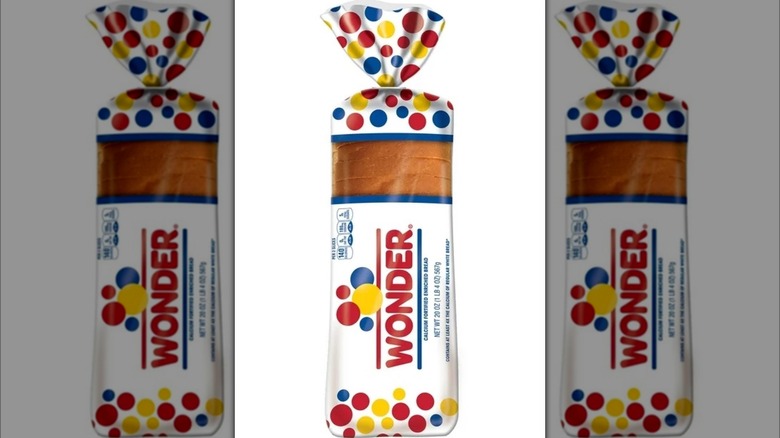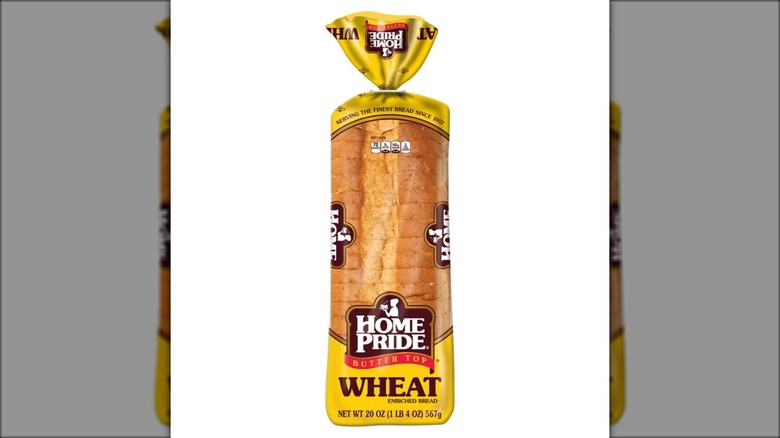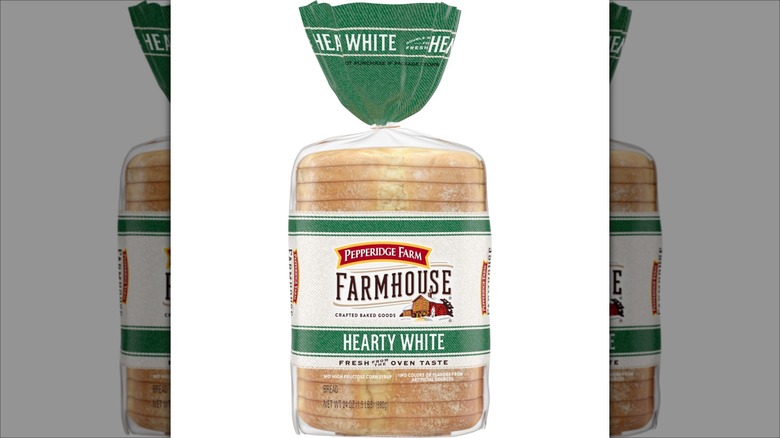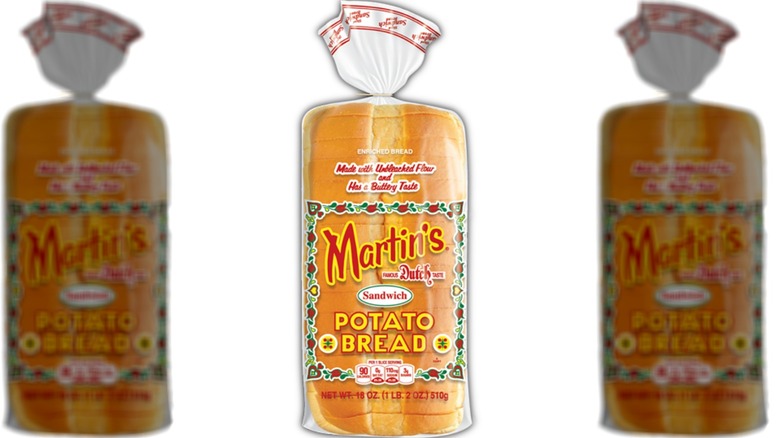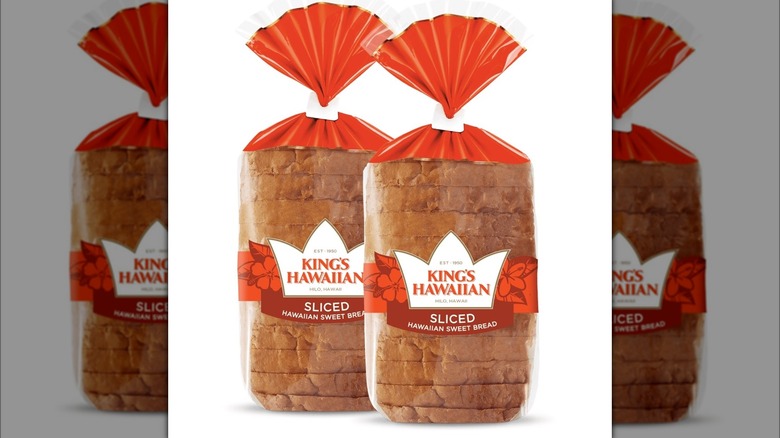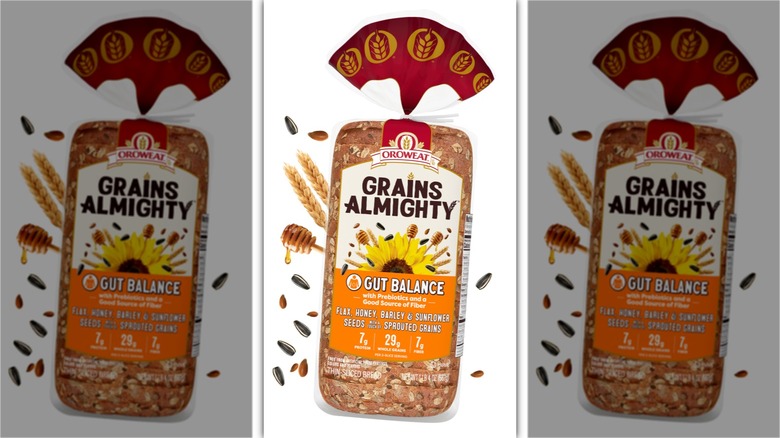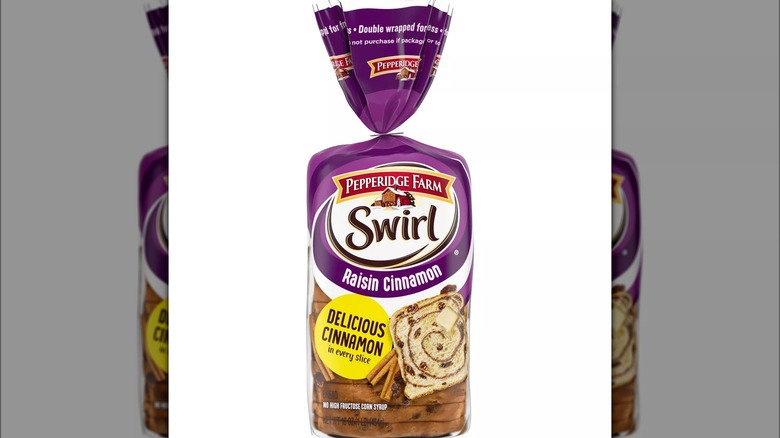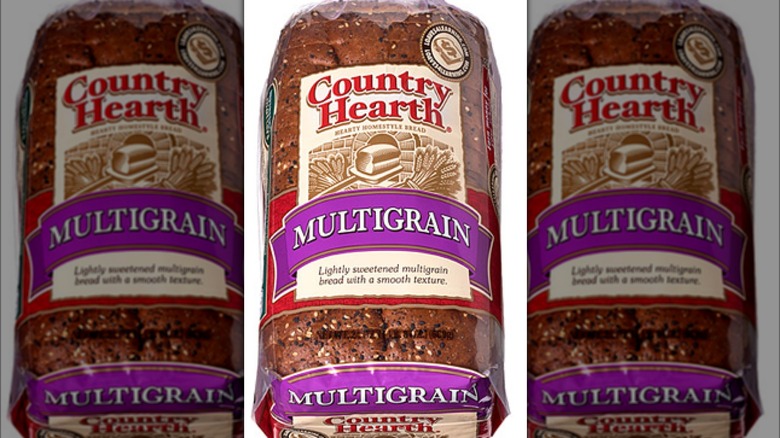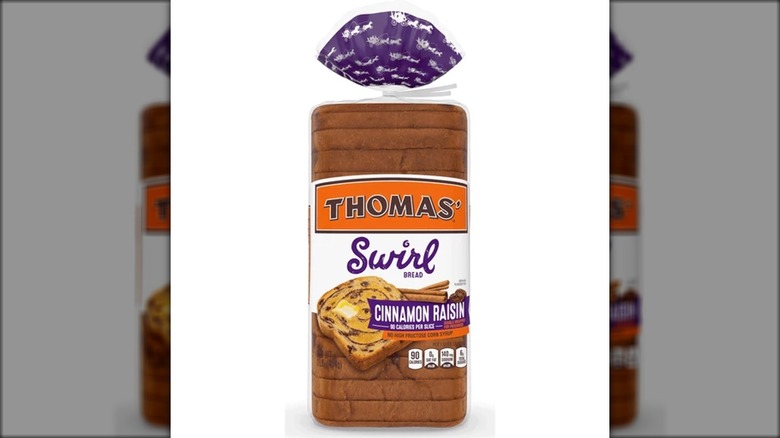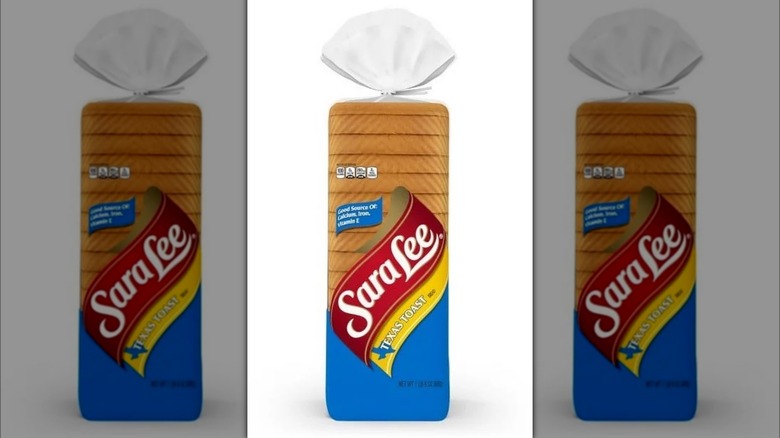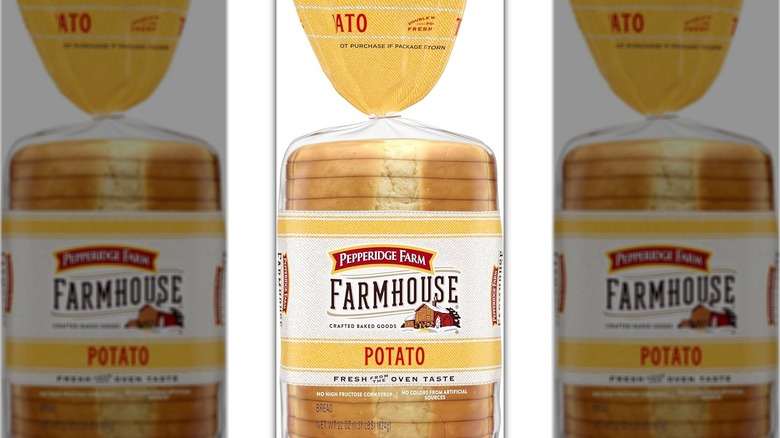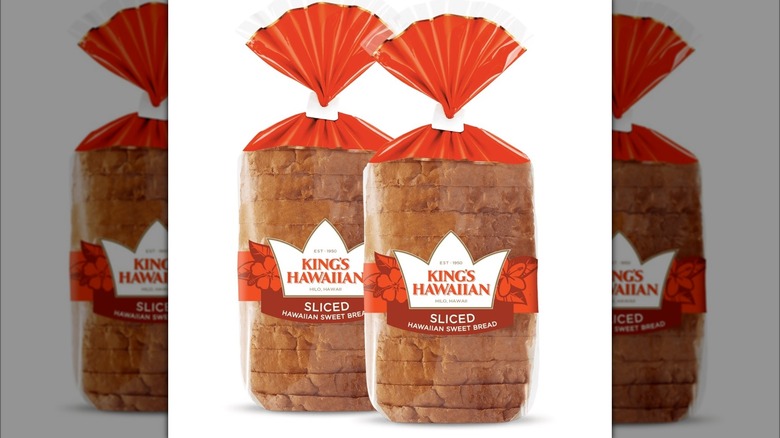The Unhealthiest Store-Bought Bread You Can Buy
We may receive a commission on purchases made from links.
As a society, we've become far too comfortable throwing around the phrase "the best thing since sliced bread" because, really, has anything even come close? Every carb-lover knows that good bread can make or break a meal. However, we also know that some breads are healthier than others. While bread should theoretically pack a fiber-filled punch, a lot of those on grocery store shelves are packed with extra additives intended to enhance their taste and lifespan. As with most foods, it's the bread with the longer ingredient lists that typically disappoint dietitians, with the majority of experts advising against anything containing dough conditioners, preservatives, and artificial flavors or colors.
If you're looking for a quick way to identify not-so-healthy bread, we recommend taking a quick look at its sodium content. Bread is the average American's primary source of sodium, with some breads containing as much salt as seawater. The daily recommended intake is 2,300 milligrams (about one teaspoon), so while a slice containing 200 milligrams may seem innocuous enough, remember that very few people eat just one slice.
But sodium isn't the only deciding factor. We've trawled through the nutritional info of dozens of brands to find those that don't easily align with the FDA guidelines for a healthy diet. Whether you're whipping up a PB&J, BLT, or your morning toast, here are 13 of the unhealthiest options on grocery store shelves.
Food Club Old Fashioned 12 Grain Enriched Bread
Like all Food Club products, the Old Fashioned 12 Grain Enriched Bread promises to "add flavor to life." As the name suggests, each slice combines a whopping 12 different grains — including sunflower seed kernels, whole wheat flour, wheat bran, barley flakes, and triticale flakes — which seemingly promises a healthy dose of fiber with every bite.
Except, there's not. In fact, there's barely any fiber at all. Each slice of Old Fashioned 12 Grain Enriched Bread contains just 1 gram of dietary fiber, which means that you could chow down two entire sandwiches and still have had just 16% of your daily recommended intake. All ingredients on store-bought foods are listed by quantity, and considering that the first ingredient mentioned on the back of Old Fashioned 12 Grain Enriched Bread is regular old highly-processed enriched unbleached flour (which is stripped of fiber during the manufacturing process), it seems like those grains touted on the packet don't play an overly important role in the recipe.
Lack of fiber aside, this bread is pretty disappointing across the board. It contains not one but four sources of added sugar (light brown sugar, honey, molasses, and raisin juice concentrate), and is notably high in sodium (190 milligrams per slice), which can contribute to high blood pressure. Also, it features monoglycerides, something health experts have theorized contains small amounts of trans fats.
Wonder Bread Classic White Sandwich Bread
Wonder Bread is soft, fluffy, and a childhood staple, but nobody today would consider it a health food. Back in the 1940s, it was a different story. In the face of widespread pellagra and beriberi outbreaks — conditions caused by a lack of niacin and thiamin — the brand started using flour fortified with various vitamins and minerals that was subsequently accredited with helping to eradicate both diseases.
Fast forward 80 years, and Wonder Bread's reputation isn't quite as wonderful as it was in the 20th century. It's low in fat, but two slices of Wonder Bread Classic White Sandwich Bread contain 8% of your daily sodium allowance (and that's before you add any peanut butter, meat, or cheese to your sandwich). It also contains a long list of preservatives, flavor enhancers, and stabilizers about which nutritionists aren't too keen, such as DATEM and monoglycerides, and packs more sodium per portion than the average bag of potato chips. While Wonder Bread likes to brag about containing as much calcium as an 8-ounce glass of milk, in light of its other downfalls, you may just be better off downing the milk instead.
Home Pride Butter Top Wheat Bread
We'll give credit where it's due: Home Pride Butter Top Wheat Bread is relatively low in calories and fat, at 70 calories and 1 gram (none of which is saturated fat) per slice. When you dive into its ingredients list, however, all it takes is four little words to understand why this made it onto our breakdown of the unhealthiest bread: high fructose corn syrup.
The archnemesis of dietitians everywhere, high fructose corn syrup has been linked to insulin resistance, Type 2 diabetes, and high blood pressure. Experts also say that it increases the amount of fat in our livers, potentially triggering non-alcoholic fatty liver disease. There's been a push to ban or more strictly regulate this sweetener in the past, but most brands continue to use it because it's significantly cheaper than regular sugar. Dragging the nutritional value of Home Pride Butter Top Wheat Bread down even further are multiple other unfavorable ingredients that all point towards a highly processed product, such as enriched wheat flour (an artificially manufactured equivalent of regular wheat flour) and monoglycerides.
Pepperidge Farm Hearty White Bread
It's easy to fall into the trap of thinking that because Pepperidge Farm has the word "farm" in its name, its products are full of homegrown, wholesome ingredients. Unfortunately, this isn't quite true of its Hearty White Bread, which falls short of several nutritional standards. The biggest is that this bread is high in sodium. And we mean extremely high in sodium — each slice contains 230 milligrams, which means a single sandwich will eat up a significant chunk of your daily recommended sodium intake.
Scanning its ingredient list, there are a few that immediately scream low-quality bread. DATEM (also known by its far less catchy moniker of diacetyl tartaric acid esters of monoglycerides) is a dough conditioner that's considered safe by the FDA, but was previously found to contribute to "heart muscle fibrosis and adrenal overgrowth" in a study by Utrecht University on rats, as well as being linked to leaky gut syndrome. Despite not being a particularly sweet bread, each slice contains 4 grams of sugar. We can't even praise this bread for its fiber content because it only contains 1 gram per serving. Overall, not a particularly stellar lineup. We recommend leaving this bread on the farm.
Martin's Potato Bread
Potato bread tends to contain similar amounts of calories and protein to standard white bread but is usually far richer in fiber. That's not the case here, as Martin's Potato Bread contains just 1 gram of dietary fiber per slice — the same, if not less, as other breads on this list.
There's a simple explanation as to why Martin's isn't packed with fiber. Its bread uses reconstituted potatoes, which can lack the same nutritional value as their non-reconstituted counterparts. We'll give it bonus points for its relatively low sodium levels at 105 milligrams per slice, and the fact it contains zero cholesterol. However, it's let down by also containing 3 grams of sugar and DATEM, not to mention a boatload of other processed additives that sound more suited to a science lab than a loaf of bread. The same is equally true of other varieties of Martin's Potato Bread, including its Sandwich Rolls and Sweet Dinner Potato Rolls.
King's Original Hawaiian Sweet Sliced Bread
Any bread with the word "sweet" in its name promises a pretty sugary experience. True to its word, King's Original Hawaiian Sweet Sliced Bread contains both sugar and liquid sugar, contributing 6 grams of added sugar per piece. Delicious though that may make any PB&J using this bread, it also means that you'll be halfway through your daily recommended added sugar allowance – implemented by the USDA to help lower the risk of serious health concerns, such as heart disease, diabetes, and cancer — before you even add jelly to your sandwich. Yikes.
What makes this bread even more disappointing is the amount of fiber. By this, we mean there's basically no fiber in each serving — just 0.5 grams. For context, you'd get more fiber from a packet of Reese's Peanut Butter Cups than two slices of King's Original Hawaiian Sweet Sliced Bread. Each slice is also pretty caloric at 120 calories per piece or 240 calories per sandwich. You'd be better off thinking of this bread as a dessert than a daily staple.
Oroweat Grains Almighty Gut Balance Bread
Everything about Oroweat Grains Almighty Gut Balance Bread sounds so promising. According to the Oroweat website, it's baked with "gut-fortifying" prebiotics that feed the friendly bacteria in your stomach, and whole grains such as flax and barley. That means it's solid on the fiber front at 3 grams per slice. It's also surprisingly high in protein with 7 grams a slice and is free of high fructose corn syrup and artificial colors, preservatives, and flavors.
Where it disappoints is the sodium content. A serving of Oroweat Grains Almighty Gut Balance Bread — which is two slices — contains 310 milligrams, which is 13% of the amount of sodium you're supposed to eat in an entire day. It also contains 4 grams of sugar from three different sources: sugar, honey, and molasses. There's a significant amount of fat, too, with 4 grams coming from soybean and palm oils.
Pepperidge Farm Raisin Cinnamon Swirl Bread
Back to the farm again, but this time, it's the Pepperidge Farm Raisin Cinnamon Swirl Bread that's got us concerned. As you may expect from something containing raisins and cinnamon, this isn't designed as a savory bread to pair with turkey and cheese, but as a sweet treat or breakfast item.
A slice of Pepperidge Farm Raisin Cinnamon Swirl Bread contains just 100 calories and is free of high fructose corn syrup. Regardless, it's surprisingly high in sugar — even for bread of this kind. That same slice contains 9 grams of sugar, five of which are added sugars. That means 27% of its total weight is made up of sugar, and that two slices would consume about half the amount you're meant to eat in a single day. Unsurprisingly, there's also not much to say about its fiber offerings. You'll get 1 gram of dietary fiber in each slice, which is far below the 3 to 5 grams that nutritionists like to see in each serving of bread.
Country Hearth Multigrain Bread
Multigrain bread is a popular choice among nutritionists, who praise its protein and fiber levels and its ability to improve gut health. However, bread can only reap these benefits if its main ingredients are whole grains, which is absolutely not the case with Country Hearth Multigrain Bread. The first ingredient mentioned on each loaf is enriched unbleached flour — yep, the same flour used for standard white bread.
While its fiber content is slightly higher than a lot of entries on this list at 2 grams per slice, there aren't really many redeeming features for the Country Hearth Multigrain Bread. It contains four different sources of added sugar (light brown sugar, molasses, raisin juice concentrate, and honey), giving each slice a total of 3 grams, and is packed with additives and preservatives. That includes calcium propionate, a salt that's used to extend the lifespan of baked goods and is "generally recognized as safe" by the FDA, but has previously been found to increase blood glucose and potentially increase the risk of diabetes in a Harvard study.
Thomas Cinnamon Raisin Swirl Bread
Thomas' Breads touts its Cinnamon Raisin Swirl Bread as its most popular flavor, and we're not surprised. Everything about this bread screams indulgence, from the swirls of luxurious cinnamon to heaps of juicy raisins. Unlike a lot of baked goods, this indulgence doesn't translate to high fat content. However, it does give it a pretty hefty amount of sugar at 6 grams per slice.
If you're looking for nutritional value, there's not much to be found here. Each slice contains next to no dietary fiber at less than 1 gram a slice, and the majority of its ingredient list is made up of the typical hallmarks of highly processed foods, such as monoglycerides, calcium propionate, soy lecithin, and DATEM. While we're all for grabbing a slice of this as a sweet treat once in a while, this definitely isn't the kind of bread you want to be reaching for if you're after a remotely healthy snack.
Sara Lee Texas Toast
By its very nature, fluffy, buttery Texas Toast is unhealthier than most breads as it's sliced at twice the usual thickness. The Sara Lee Texas Toast still requires a shoutout, though, for its sodium content. A single slice of this bread contains 200 milligrams of sodium (9% of your daily recommended intake).
As is often the case with unhealthy bread, this is paired with a resounding lack of fiber. In fact, each slice has less than 1 gram of fiber, which isn't just low but borderline non-existent. Its main ingredient is the usual culprit in white bread, enriched wheat flour, which means it's not offering too much in terms of nutritional value. It also contains calcium propionate, which, as we mentioned before, isn't the most popular preservative thanks to its potential impact on blood glucose. We will, however, give it bonus points for being a pretty good source of calcium at 210 milligrams a slice.
Pepperidge Farm Farmhouse Potato Bread
The Pepperidge Farm Farmhouse Potato Bread does contain both potatoes (well, dehydrated potatoes) and potato flour, but neither is the major ingredient. Instead, it's the repeat offender of enriched wheat flour that crops up first in the ingredient list, meaning all the bran and germ leaves were sifted out, and very little dietary fiber remains. That becomes pretty evident once you look at the nutritional information; you'll only find 1 gram of fiber per slice here.
In place of fiber, you'll find 4 grams of added sugar in Pepperidge Farm Farmhouse Potato Bread and a significant amount of sodium at 190 milligrams. Put into context that means that a sandwich made with this bread is going to count as 16% of both your daily recommended sugar and sodium intake. Tasty though it may be, there are definitely healthier potato breads out there — and it's surprisingly easy to make your own at home.
King's Original Hawaiian Sweet Rolls
Just like King's Hawaiian Sweet Sliced Bread, the King's Original Hawaiian Sweet Rolls take inspiration from classic Portuguese sweet bread, which means they're practically defined by sugar. That means that the sugar content of these soft, buttery rolls shouldn't come as too much of a surprise. Each roll contains 5 milligrams, which is 1 gram less than their sliced bread counterpart.
However, in other nutritional aspects, the rolls actually perform even worse in ways that you wouldn't have believed possible. While the sliced bread contains a measly 0.5 grams of fiber per slice, a King's Original Hawaiian Sweet Roll offers a grand total of 0 grams. They're light in the sodium department at 70 milligrams a roll, which is a plus, but half of each roll's fat content comes from saturated fat. You'll also find a lengthy list of scientific-sounding additives in the ingredients list — such as ammonium sulfate, sorbitan monostearate, and microcrystalline cellulose — all of which are surefire indicators that a product has been highly processed.
How we chose the unhealthiest breads
In our mission to find the unhealthiest bread, we studied the nutritional info of dozens of offerings stocked in major chains such as Walmart, Target, and Kroger. While we started by looking at the calories, it's important to note that these aren't everything — and definitely don't always reflect a food item's true nutritional value. Instead, we put more stock in each item's sodium and sugar content (especially its added sugars), comparing it to the daily recommended values provided by the USDA.
As well as cross-referencing this with the amount of fat or cholesterol in each bread, we spent a lot of time checking out the actual ingredients that contribute to these values. We were looking for bread that contained an excessive amount of additives or other ingredients often found in highly processed baked goods, such as DATEM, emulsifiers, and high fructose corn syrup.

